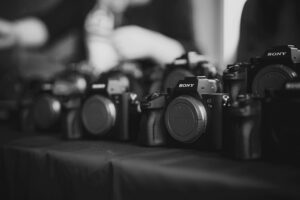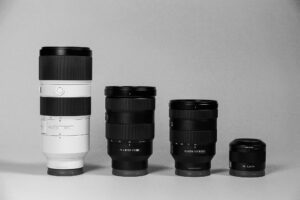Buying a new camera -whether it’s your first or an upgrade- can feel overwhelming. With so many brands, models, and specs to compare, it’s easy to get stuck in research mode. That’s why having a clear checklist helps. In this guide, we’ll walk you through the essential things to consider before making a purchase, from setting your budget and defining your needs to thinking about lenses and deciding whether to buy new or used.
Use this list as your decision-making roadmap to avoid regrets and make a purchase you’ll be happy with. (If you haven’t yet decided on a type or model, see our how to choose a camera post first.)
TL;DR:
- Set a realistic budget that covers both camera and accessories
- Define your goals: what types of photography or video will you shoot?
- Pick the right type: DSLR, mirrorless, compact, or cinema camera
- Think long-term about lenses, especially if you plan to upgrade later
- Check real-world reviews and sample footage/images before buying
- Try the camera in person if possible to feel the ergonomics and controls
- Compare buying options: new, used, refurbished, and grey market
This post is just one part of my “Camera Buying Guide“, which you can download as a pdf file right now.
1. Set Your Camera Budget and Stick to It
Start by deciding how much you’re willing to spend: not just on the camera body, but also on lenses, memory cards, batteries, and a bag. Here’s a rough guide to what you can expect:
- Under $500: Entry-level compact or budget mirrorless cameras (often older or used models)
- $500-$1,000: Mid-range mirrorless or DSLR with a kit lens
- $1,000-$2,000: Better lenses, full-frame bodies, or hybrid cameras with strong photo and video performance
- $2,000+: Professional-level cameras or more specialized gear
Tip: Don’t spend your entire budget on the camera body. Leave room for at least one good lens and essential accessories.
2. Identify What You’ll Be Using the Camera For
Ask yourself these key questions:
- Photo or video, or both?
- Portability or performance?
- Auto mode or full manual control?
- Will you use it daily, occasionally, or just while traveling?
Your answers should help you narrow down your options.
3. Pick the Right Camera Type (DSLR, Mirrorless, or Compact)
Use your needs and budget to decide which type of camera fits best:
- Compact: Great for casual photography and travel
- Mirrorless: Ideal for hybrid shooters and those who want modern tech in a small package
- DSLR: A solid choice for photography-first users, especially with a focus on lenses
- Action Camera: For outdoor adventures, POV footage, and sports
- Cinema Camera: If your priority is video and you’re aiming for professional quality
See the camera types explained guide, if you’re still unsure.
4. Plan for Lenses: Now and in the Future
If you’re buying a mirrorless or DSLR camera, remember: the body is only part of the equation. A great lens makes a huge difference in quality.
- Research the lens ecosystem for your camera brand (Canon, Sony, Fujifilm, etc.)
- Check availability and prices of lenses you may want to buy later
- If you’re on a budget, make sure there are affordable lens options for your system
5. Read Reviews and Watch Sample Footage or Photos
Search for real-world reviews and sample photos or videos shot with the camera you’re considering. YouTube, DPReview, Flickr, and Instagram are great sources.
Look up the model name + “review” or “sample photos” to get a feel for what the camera can actually do.
6. Test the Camera in Person (If You Can)
If you’re buying your first camera, try it out in person if you can. Visit a store, rent it for a day, or borrow one from a friend. You’ll learn a lot just by holding the camera and testing the menu system and autofocus.
7. Buy Smart: New, Used, Refurbished, or Grey Market?
Finally, purchase from a reputable seller. Avoid grey market imports (no warranty or support), and double-check that you’re getting the correct model (some have confusing names or region-specific variations).
Reminder: This post is just one part of my “Camera Buying Guide“, which you can download as a pdf file right now.
Last Words
A camera is an investment in your creative journey. So take your time, do the research, and trust your instincts. There’s no one-size-fits-all answer, but with a solid checklist and a clear understanding of your needs, you’ll be in a great position to choose a camera that works for you now and continues to serve you as you grow. And remember, the best camera is the one that makes you want to go out and create.
FAQ
What’s the most important thing to start with on a camera-buying checklist?
Define your budget -including accessories- not just the camera body, so you’re not left high-and-dry with incomplete gear.
Should I buy a camera in-store or online?
If possible, test it in person to judge ergonomics and menu layout. If buying online, rely on trusted reviews and sample footage.
Is buying used or refurbished a good idea?
Yes, as long as you buy from a reputable seller, used gear can save money. Stick with sellers who offer warranties or easy return policies.




